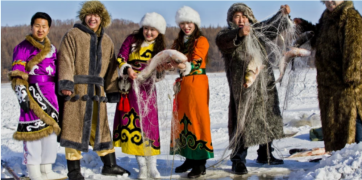
The Hezhes are one of the smallest ethnic minority groups in China. The latest official survey (2020) of the population of the Hezhes was 5,373. To understand the Hezhe people, one has to know the importance of fish in their life and culture. Fish is their main food source, so all the Hezhe people settle by the river plains of Heilongjiang’s three major rivers.
1.What can we learn about Hezhe people?
A There are 6,000 of them now.
B They live deep in the mountains.
C They mainly live on fish.
D They used to fish all year round.
解析:选C。C 细节理解题。根据第一二段内容可知,2020年人口普查显示赫哲族人口为5,373人,但现在的人口数量并不清楚;鱼是赫哲族的主要食物来源;所有赫哲族都定居在黑龙江三江流域平原一带,并非深山里;在历史上,赫哲族人会在春天、秋天和冬天捕鱼,并非一年四季都捕鱼。故选C。
2.What does the underlined word “catch” refer to?
A Nets.
B Boats.
C Fish.
D Coats.
解析:选C。C 词意指代题。根据划线词所在句的后一句“They eat some fish raw and dry or freeze and store the rest.”他们生吃一些鱼,其余的鱼就晒干或者冷冻之后储存起来,由此可知,catch指的是他们捕捞到的鱼。故选C。
3.What does the last paragraph mainly tell us about Hezhe people?
A Their artistic talents.
B Their religious beliefs.
C Their unique art form.
D Their daily activities.
解析:选B。B 段落大意题。根据最后一段中的关键词句“The Hezhe people believe in Shamanism”“They believe that the world is created by the gods”可知,本段主要描写了赫哲族的信仰。故选B。
4.Where is the text most probably from?
A A travel brochure.
B A science report.
C A history textbook.
D A culture magazine.
解析:选D。D 推理判断题。通读全文可知,本文主要介绍了中国少数民族之一赫哲族的生活、文化、宗教等相关情况,因此本文最有可能来源于一本文化杂志。故选D。